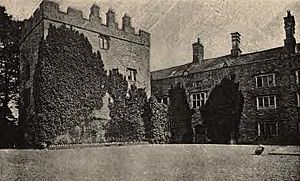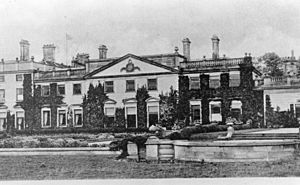Sir Wilfrid Lawson, 1st Baronet, of Isell facts for kids
Sir Wilfrid Lawson, 1st Baronet, of Isel Hall, Cumberland (born around 1610, died 1688) was an important English landowner and politician. He served as a Member of Parliament in the House of Commons from 1660 to 1679.
Contents
Sir Wilfrid Lawson's Life
Wilfrid Lawson was born in 1610. His parents were William Lawson and Judith Bewley. His great-uncle, also named Sir Wilfred Lawson, had acquired the family estate of Isel. This great-uncle also served as a Member of Parliament for Cumberland.
Wilfrid Lawson studied at Queen's College, Oxford in 1628 when he was 17. King Charles I made him a knight in 1641. This was an honor given by the King.
Lawson and the English Civil War
Even though King Charles I knighted him, Wilfrid Lawson supported the Parliament during the English Civil War. This war began in 1642. He was on the side known as the Roundheads.
Lawson set up a military base on St Herbert's Island in Derwent Water. This island was part of his land. By 1644, he became the main commander for Cumberland. He held local government jobs throughout the time when England had no king, known as the Interregnum. He also served in Richard Cromwell’s Parliament. However, his loyalty to the Parliament was questioned, and he was even put in prison for a time.
In 1643, he tried to take Carlisle Castle for Parliament. But local landowners and the local army stopped him. They chased his forces to Abbey Holme. They only released them when Lawson's men promised to stop fighting.
Lawson was the High Sheriff of Cumberland several times: in 1635, from 1645 to 1647, and from 1652 to 1657. He inherited Isel Hall around 1654 after his father passed away.
Political Career
In 1659, Lawson was chosen as a Member of Parliament (MP) for Cumberland. He was re-elected as MP for Cumberland in 1660 for the Convention Parliament. This Parliament helped bring the King back to power.
Lawson was not very active in the Convention Parliament. But he was part of 11 committees. These included committees for elections and land purchases. After the King was restored to the throne in 1660, Lawson was also on committees looking into church matters.
In 1660, there was a discussion about an "indemnity bill." This bill was about forgiving people for actions during the war. A man named Christopher Clapham wanted Lawson to pay money to Sir Jordan Crosland. This was for things taken from Rydal Hall during the war. Lawson spoke in his own defense. He said he "never saw any plate or moneys." The Parliament accepted his explanation.
In 1661, Lawson became an MP for Cockermouth. He had a strong influence there until 1679. He was one of the less active members of the Cavalier Parliament. He seemed to support the King's side. He was added to the elections committee in 1666. He also worked on bills to help poor prisoners.
In 1688, shortly before he died, Lawson bought a special title from King James II. This title was a baronetcy, which cost about £2,000. He also bought Brayton from the Salkeld family.
Lawson Family
Sir Wilfrid Lawson passed away in 1688. He had married Jane Musgrave. She was the sister of Sir Edward Musgrave, 1st Baronet. Sir Wilfrid and Jane had five sons and eight daughters. Twelve of their children grew up and got married.
Here is an inscription from Isel church about them:
Here lies Sir Wilfrid Lawson, baronet, and his Lady Jane
He departed this life 13th day of December 1688 aged 79
And she the 8th June 1677 aged 65. Having married four
sons and eight daughters. Vivit post funers virtue.
Their oldest son, William, married Milcah Strickland. She was the daughter of Sir William Strickland, 1st Baronet. William and Milcah had a son named Wilfrid and two daughters. Sadly, William lost his eyesight and died before his father.
Sir Wilfrid Lawson arranged for his family estate at Isel to go to his grandson, Wilfrid (William's son). This grandson later became Sir Wilfrid Lawson, 2nd Baronet.
Sir Wilfrid also left the lands of Brayton, Bassenthwaite, Hensingham, and Loweswater to his second son, also named Wilfrid. This second Wilfrid was an MP for Cockermouth. This is how the 'Brayton' line of Lawsons began. The baronetcy eventually passed to this line. This second Wilfrid also died before his father. So, Brayton went to his son, Gilfrid.
Lawson Family History
The Lawson family comes from John Lawson. He was a lord in Yorkshire in 1216. This was during the time of King Henry III. Many important ancestors came before Sir Wilfrid Lawson (1545–1632). He was the son of Thomas Lawson.
After Thomas Salkeld of Whitehall died, his lands, including Brayton, went to his three daughters. In 1658, these daughters, through their representatives, transferred the Brayton lands to Sir Wilfrid Lawson of Isel. This was the great-uncle of the 1st Baronet.



